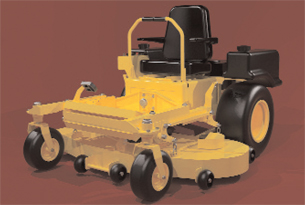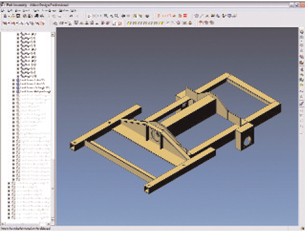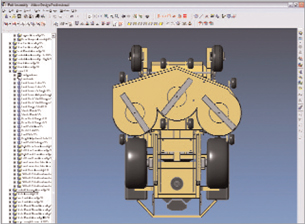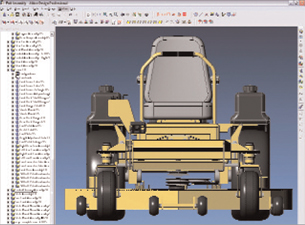Latest News
July 2, 2008
By Russell Shuba
 Alibre Design enabled this mower to meet both a patent deadline and a show-floor appearance. |
In this day and age, how many of us know an inventor who has spent a quarter of a century designing, building, testing, using, and perfecting his invention? Vern Godfrey of Warrensburg, MO, is one of this disappearing breed. The makers of Alibre Design MCAD software are proud to have been a part of his journey to design and patent the Zero Turn Radius (ZTR) mower — The BeeLine.
The mower’s unique features include a two-piece, pivoting frame that follows ground contours more smoothly and accurately than existing designs, tubular automotive shock absorbers that provide a smooth ride, and a front-frame design that provides a quick-disconnect system on the deck for maintenance. The simplicity of the mower’s design makes it practical for the residential market and yet rugged enough to withstand demanding commercial conditions.
After 25 years of designing and building without design drawings, and working with a ninth prototype, Godfrey felt he was ready to introduce his mower to the market at the industry’s largest exposition in late October.
 Basic front and rear frame members of the BeeLine’s box construction. |
He hired a lawyer to usher his machine through the patent process to protect his intellectual property on the unique design and decided that the one prototype — with 300 mowing hours logged — might work for the outdoor demonstration area, but would not do for the indoor booth space where it would be flanked by other shiny new models.
A Race Against Time
While Godfrey had taken numerous photographs of his prototype, his attorney informed him that the patent office required a set of drawings with a very specific format and layout, and photographs just wouldn’t do. In the meantime, Godfrey had registered his invention at the Green Industry and Equipment Expo in Louisville, KY, and needed to build a floor model. The only problem was, the show was less than three months away.
Over the span of 25 years, Godfrey developed prototypes by building parts and testing them. If they didn’t work, he tinkered with them until they did. Now with two impending deadlines looming, Godfrey looked to his son Jeff, who writes manufacturing software for a living, to step in as the design engineer on the project and create drawings of the ninth prototype in his spare time while Godfrey built the tenth prototype.
 Engine, seat, gas tanks, foot plate, and control panel added. |
Jeff started by trying to trace photographs and convert them into 2D drawings. “While my attempts may have eventually worked,” says Jeff, “for all my efforts, I would have ended up with a few 2D drawings. If later I needed a view from a different angle, a view with certain parts hidden or anything to be different, there was no way to do that.” Then he tried an old copy of an MCAD program that was too expensive to upgrade. Because he was still working in flat 2D drawings without parametrics, changing any dimensions was extremely time-consuming with the extensive drawing rework required.
“It was impossible to get from where I was to where I wanted to be without losing much of my work,” Jeff says. “I was just spinning my wheels.”
Alibre to the Rescue
Jeff searched online for free MCAD programs that could do 3D parametrics and found a 30-day free trial of Alibre Design. He downloaded the software and started using it to model the prototype. He says he found it easy to learn, with all the features he needed to model a relatively complex piece of equipment, so he started over.
“I did my homework, and there is nothing out there anywhere near Alibre’s capabilities for the price,” says Jeff. “Alibre Design is incredibly easy to use. We’re not a big company and every dollar counts. Besides, why pay for stuff you don’t need?”
Without any formal training in the program, Jeff completed modeling the entire mower’s more than 200 parts in his spare time in six weeks. He did this by learning Alibre Design, measuring and sketching each part of the prototype parked in his driveway, and modeling them accurately on his computer.
Easy Process Mirrors the Real World
Jeff modeled the patentable features of the BeeLine mower, showing how it uniquely overcomes one of the greatest shortcomings of most mid-mount mowers — the difficulty of deck maintenance, including safely sharpening and changing the blades. So Jeff modeled the process of how one person can remove the mower deck, roll it in front of the mower, and tilt it vertically in four minutes without the aid of additional tools or a jack.
“Although I was working with complex functions,” he says, “I had the comfort that I could visibly show each step without having to redo any of my design work.”
 Control arms, control linkages, shock towers, and deck hangers added. |
Key to Jeff’s ability to model the mower deck maintenance process is Alibre’s ability to apply 3D constraints. As opposed to simply arranging static parts in 3D space, Alibre allowed Jeff to capture how the parts are actually assembled together, enabling him to do things like simulate motion and check for interferences.
Once these 3D constraints were in place, Jeff created interactive 3D PDF files to animate and simulate the motion of the mechanism. To be ready for the Green Industry and Equipment Expo, the folks at BeeLine were working on two prototypes, a video, and a website simultaneously.
Clearly, one of the most important parts of this design process was the automatic creation of precise 2D drawings for the patent application from Jeff’s 3D models. And during the course of creating the model, if the design changed, the drawings automatically updated with the push of a button, saving hours of 2D drawing rework time and simultaneously satisfying the patent office’s specific requirements.
Earning Patent-Pending Status
One of those requirements was illustrating how the mower’s suspension worked, and Jeff had one day to model it. Alibre Design’s parametric capability enabled him to set up and test the mechanical linkage of parts and show how the tubular automotive shock absorbers twist in different directions to create a smooth ride.
 A front view showing shocks, linkage, and deck height controls added. |
“I could not have shown the motion in 3D space without Alibre Design,” says Jeff. “We would not have made the patent-filing deadline without it.” He explained that for the price, it was the only software “remotely in the ballpark.”
In the end, he said, Alibre saved countless hours and resulted in drawings being delivered to the patent attorney five days ahead of schedule.
According to Jeff, the elder Godfrey, though lacking computer skills, realized the advantage of modeling when he decided to make some fairly significant frame design changes to his machine for the show-floor model. Because the basic design and core components already existed, the redesign for the new version only took a few days. Once modeled, the new prototype was fabricated, painted, and assembled in about seven weeks. Godfrey started up the new mower, drove it onto the trailer next to the demonstration mower, and drove to the show where, say the builders, it was a tremendous success.
More Info:
Alibre
Richardson, TX
alibre.com
BeeLine
Warrensburg, MO
beelinemowers.com
Russell Shuba is a freelance writer who lives outside Madison, WI. He can be found plying the north country’s lakes in a homemade kayak. To comment on this article, send an e-mail addressed to DE-Editors @digitaleng.news.
Subscribe to our FREE magazine, FREE email newsletters or both!
Latest News
About the Author
DE’s editors contribute news and new product announcements to Digital Engineering.
Press releases may be sent to them via [email protected].






